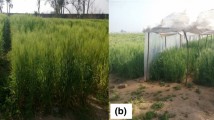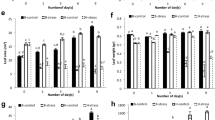Abstract
From precise drought tolerance screening of local rice landraces of Koraput, six rice landraces were identified as superior drought tolerant capacity in our earlier study. However, little information is available on their physiological response of redox regulation and photochemical activity under drought stress. The present work evaluates their redox regulations driven by ascorbate–glutathione cycle and photochemical activity of photosystem II under simulated drought stress by polyethylene glycol 6000. Leaf chlorophyll content, electron transport rate and effective quantum yield of PSII were significantly higher in studied indigenous rice genotypes in comparison with susceptible check variety under drought condition. Further, greater quantities of ascorbate and elevated levels of ascorbate–glutathione cycle enzyme activities were observed under drought treatment in studied indigenous rice genotypes in compared with susceptible IR64. The findings suggested that maintenance of better photochemical activity in studied rice genotypes under water-deficit condition may be due to improved redox regulation of ascorbate and efficient ascorbate regeneration pathways. This study thus shows a new light into drought stress response of indigenous rice of Koraput with global implications.
Similar content being viewed by others
References
Arnon DI (1949) Copper enzymes in isolated chloroplasts. Polyphenol oxidase in Beta vulgaris. Plant Physiol 24(1):1–15
Arunachalam V, Chaudhury SS, Sarangi SK, Ray T, Mohanty BP, Nambi VA, Mishra S (2006) Rising on rice: the story of Jeypore, vol 1. MS Swaminathan Research Foundation, Chennai, p 39
Bhattacharjee S, Dey N (2018) Redox metabolic and molecular parameters for screening drought tolerant indigenous aromatic rice cultivars. Physiol Mol Biol Plants 24(1):7–23
Farooq M, Kobayashi N, Wahid A, Ito O, Basra SM (2009) Strategies for producing more rice with less water. Adv Agron 101:351–387
Gill SS, Tuteja N (2010) Reactive oxygen species and antioxidant machinery in abiotic stress tolerance in crop plants. Plant Physiol Biochem 48(12):909–930
Mishra SS, Behera PK, Panda D (2019) Genotypic variability for drought tolerance-related morpho-physiological traits among indigenous rice landraces of Jeypore tract of Odisha, India. J Crop Imp 33:254–278
Mishra SS, Panda D (2017) Leaf traits and antioxidant defense for drought tolerance during early growth stage in some popular traditional rice landraces from Koraput, India. Rice Sci 24(4):207–217
Murchie EH, Lawson T (2013) Chlorophyll fluorescence analysis: a guide to good practice and understanding some new applications. J Exp Bot 64(13):3983–3998
Nahar S, Vemireddy LR, Sahoo L, Tanti B (2018) Antioxidant protection mechanisms reveal significant response in drought-induced oxidative stress in some traditional rice of Assam, India. Rice Sci 25(4):185–196
Panda D, Mishra SS, Mohanty SK, Behera PK, Lenka SK (2019) Data on genetic potentiality of folk rice (Oryza sativa L.) genotypes from Koraput, India in reference to drought tolerance traits. Data Brief 25:104363. https://doi.org/10.1016/j.dib.2019.104363
Panda D, Sarkar RK (2012) Leaf photosynthetic activity and antioxidant defense associated with Sub1 QTL in rice subjected to submergence and subsequent re-aeration. Rice Sci 19(2):108–116
Panda D, Sarkar RK (2013) Characterization of leaf gas exchange and anti-oxidant defense of rice (Oryza sativa L.) cultivars differing in submergence tolerance owing to complete submergence and consequent re-aeration. Agric Res 2:301–308
Pandey V, Shukla A (2015) Acclimation and tolerance strategies of rice under drought stress. Rice Sci 22(4):147–161
Patra BC, Dhua SR (2003) Agro-morphological diversity scenario in upland rice germplasm of Jeypore tract. Genet Resour Crop Evol 50(8):825–828
Pyngrope S, Bhoomika K, Dubey RS (2013) Reactive oxygen species, ascorbate–glutathione pool, and enzymes of their metabolism in drought-sensitive and tolerant indica rice (Oryza sativa L.) seedlings subjected to progressing levels of water deficit. Protoplasma 250(2):585–600
Rao DE, Chaitanya KV (2016) Photosynthesis and antioxidative defense mechanisms in deciphering drought stress tolerance of crop plants. Biol Plant 60(2):201–218
Sahoo S, Saha B, Awasthi JP, Omsun T, Borgohain P, Hussain S, Panigrahi J, Panda SK (2019) Physiological introspection into differential drought tolerance in rice cultivars of North East India. Acta Physiol Plant 41:53. https://doi.org/10.1007/s11738-019-2841-x
Samal R, Roy PS, Sahoo A, Kar MK, Patra BC, Marndi BC, Gundimeda JNR (2018) Morphological and molecular dissection of wild rices from eastern India suggests distinct speciation between O. rufipogon and O. nivara populations. Sci Rep 8(1):2773
Sharma P, Jha AB, Dubey RS, Pessarakli M (2012) Reactive oxygen species, oxidative damage, and antioxidative defense mechanism in plants under stressful condition. J Bot 217037:1–26. https://doi.org/10.1155/2012/217037
Turral H, Burke JJ, Faurès JM (2011) Climate change, water and food security. Food and Agriculture Organization of the United Nations, Rome
Yoshida S, Forno DA, Cock JH, Gomez KA (1976) Laboratory manual for physiological studies of rice. International Rice Research Institute, Manila, PH
Zhang H, Liu W, Wan L, Li F, Dai L, Li D, Zhang Z, Huang R (2010) Functional analyses of ethylene response factor JERF3 with the aim of improving tolerance to drought and osmotic stress in transgenic rice. Transgenic Res 19(5):809–818
Acknowledgements
This work was supported by Science and Technology Department, Govt. of Odisha [Ref. No. 3340 (Sanc.)/ST/22.06.17] project and University Grant Commission, New Delhi for Non-NET fellowship to S.S. Mishra.
Author information
Authors and Affiliations
Corresponding author
Ethics declarations
Conflict of interest
The authors report that they have no conflict of interest.
Additional information
Publisher's Note
Springer Nature remains neutral with regard to jurisdictional claims in published maps and institutional affiliations.
Rights and permissions
About this article
Cite this article
Panda, D., Mishra, S.S., Behera, P.K. et al. Role of Ascorbate and Ascorbate–Glutathione Cycle for Photosynthetic Protection in Selected Indigenous Rice Landraces Under Drought Stress. Agric Res 10, 187–192 (2021). https://doi.org/10.1007/s40003-020-00506-y
Received:
Accepted:
Published:
Issue Date:
DOI: https://doi.org/10.1007/s40003-020-00506-y




